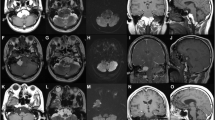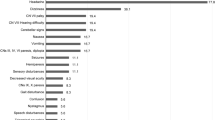Summary
Magnetic resonance imaging (MRI) was performed in five cases of intracranial epidermoid. In three of the five patients, the lowdensity mass on the CT scans showed as low intensity on the T1 and high intensity on the T2 weighted images. In the two other patients, the masses with high or isodensity on CT showed as high intensity on the T1 weighted images and as high or low intensity on the T2 weighted images. Thus, the intensity of epidermoid on MRI correlated fairly well with the CT density, although the former was more variable. The variety of intensities on MRI reflects differences in the chemical composition of the components in the epidermoid tissue in addition to differences in the solid and liquid state of the tissue. An epidermoid could have similar MRI findings as an arachnoid cyst with regard to intensities but its irregular margin provides a useful guide for differentiation. As in other tumours, MRI is superior for evaluation of the size and the extent of the epidermoid as well as the displacement of important neurovascular structures.
Similar content being viewed by others
References
Braun IF, Naidich TP, Leeds NE, Koslov M (1977) Dense intracranial epidermoid tumors. Radiology 122: 717–719
Cushing H (1932) “Intracranial tumors”. Charles C Thomas, Springfield, Ill
Davis KR, Roberson GH, Taveras JM, New PEJ, Trevor R (1976) Diagnosis of epidermoid tumor by computed tomography. Radiology 119: 347–353
Elstr AD (1988) Cranial Magnetic Resonance Imaging. Churchill Livingstone, New York Edinburgh London Melbourne
Fawcitt RA, Isherwood I (1976) Radiodiagnosis of intracranial pearly tumors with particular reference to the value of computer tomography. Neuroradiology 11: 235–242
Hackney DB, Grossman RI, Zimmerman RA, Joseph PM, Goldbegr HI, Bilaniuk LT, Spagnoli MV (1987) Low sensitivity of clinical MR imaging to small changes in the concentration of nonparamagnetic protein. AJNR 8: 1003–1008
Horowitz BL, James R, Chari MV, Bryan RN (1987) Epidermoidoma: correlation of in-vivo MR imaging with in-vitro C-13 NMR spectroscopy. AJNR 8: 964
Newton DR, Larton TC III, Dillon WP, Newton TH (1987) Magnetic resonance characteristics of cranial epidermoid and teratomatous tumors. AJNR 8, 945
Nagashima C, Takahama M, Sakaguchi A (1982) Dense cerebellopontine epidermoid cyst. Surg Neurol 17: 172–177
Pusey E, Kortman KE, Flannigan BD, Tsuruda J, Bradley WG (1987) MR of craniopharyngiomas: tumor delineation and characterization. AJNR 8: 439–444
Author information
Authors and Affiliations
Rights and permissions
About this article
Cite this article
Ishikawa, M., Kikuchi, H. & Asato, R. Magnetic resonance imaging of the intracranial epidermoid. Acta neurochir 101, 108–111 (1989). https://doi.org/10.1007/BF01410523
Issue Date:
DOI: https://doi.org/10.1007/BF01410523




